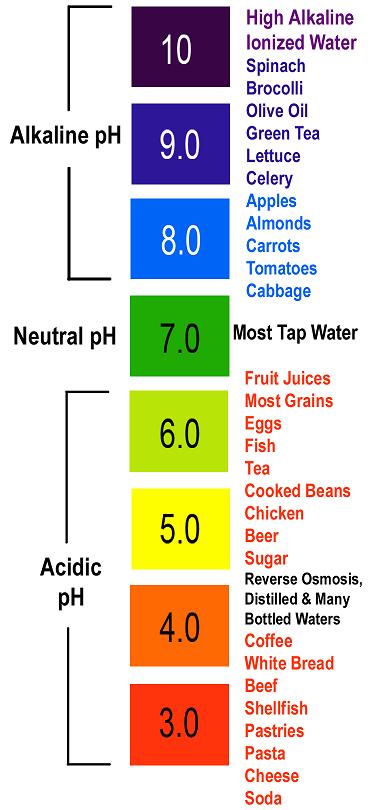Enjoy Alkaline Foods and Increase your Beautiful Health this summer.
Less inflammation in the body creates a better environment for healthier hair and skin.
The body is always striving for health, continuously cleansing itself of waste material. It’s a self-cleaning, self-healing, self-maintaining, and infinitely forgiving wondrous creation. It will always regenerate itself if given the proper natural material.
There is a difference in surviving and thriving. Our brains, body, and soul can flourish with the proper fuel!
To maintain beautiful health, an alkaline diet should consist of 60% alkaline forming foods and 40% acid forming foods. To restore your health, your alkaline diet should consist of 80% alkaline forming foods and 20% acid forming foods.
Healthy, Alkaline-Forming Fruits & Vegetables
Some fruits are highly alkaline foods…
Including apples, apricot, avocado, bananas (high glycemic), blackberries, cantaloupe, fresh coconut, real cherries, dates and figs, pears, oranges, pineapple, peaches, raisins, grapes, grapefruit, honeydew melon, lemons and limes (citric acid? more on this shortly), nectarines, raspberries, tomato, tangerine, most tropical fruits, watermelon and strawberries.
Vegetables Foods with High Alkalinity
Including most green vegetables, such as asparagus, dandelions, wheat grass, alfalfa sprouts, seaweed, sea vegetables and salt, watercress, broccoli, spinach, celery, fresh green beans, sweet potato, pumpkin, peas, peppers, onion, lettuce, mushrooms, Brussels sprouts, green beans, eggplant, garlic, escarole, cucumber, cabbage, carrot, fennel, beets, chestnuts, almonds, chili pepper, tamari, ginger and cinnamon.
Additional high alkaline-forming foods
Other food products are alkalizing or become alkaline once they are eaten. Alkalizing sweeteners include rice syrup, unprocessed maple syrup and stevia. Millet, whey protein powder, almonds, chestnuts and fermented tofu are alkalizing proteins. Alkalizing beverages include pure or mineral water, almond milk, vegetable broth, non-sweetened soy milk, fresh vegetable juice, lemon water and herbal tea. Lemons are naturally acidic, but they become alkaline after digestion.

Summer Hydrating Acid/Alkaline Food List
Hydration is so important because every organ in our bodies relies on water to function properly. Drinking water is good, drinking alkaline, ionized water is vital to keep yourself hydrated. However, food also provides hydration, in fact about 20 percent of your daily fluid needs. Some foods are better sources of hydration than others.
Watermelon
Watermelon is one of the most hydrating foods out there. It’s made up of mostly water, but it also has essential hydrating salts, calcium, magnesium, potassium and sodium. It’s perfect for those hot summer days when you need to replenish your body.
Cucumber
Composed of 95 percent water, the cucumber is a good hydrating food choice. A 4-oz. serving of cucumber contains just 7 calories and 50 ml, or 2 oz., of water. Not only is the cucumber a good source of fluids, but it is also a good source of fiber and vitamin C.
Oranges
Like cucumbers, oranges also have a high water content, consisting of 87 percent water. A 4-oz. portion of mandarin oranges provides 110 ml, almost 4 oz., of fluid. Oranges are higher in calories than cucumbers, with about 40 calories in a 1/2-cup portion, but are also a good source of fiber and vitamin C.
Green Beans
Green beans also make a low-calorie hydrating food. A 1/2 cup serving of cooked green beans contains 20 calories and 115 ml of fluid.
Apples
Apples are also a good hydrating food. One medium apple contains 110 ml of fluid. Applesauce can also help you meet your daily fluid needs, with 110 ml per 4-oz. serving. Choose the unsweetened applesauce to limit calorie intake.
Berries
Also packed with water, berries contain high levels of antioxidants, which can help the body naturally detoxify itself. Berries also deliver tons of fiber, which can help you stay satisfied in between meals.
Red Bell Peppers
All bell peppers are hydrating sources of some of the best nutrients for the body. They contain vitamin C, thiamine, vitamin B6, beta-carotene and folic acid. Red bell peppers are even better because they contain lycopene.
Pineapples
Pineapples are a delicious summer fruit. On top of the hydrating elements of pineapple, it is packed with bromelain. Bromelain has many health benefits, mainly helping with digestion. Pineapple is a great fruit to eat to help the body naturally detoxify itself and lose weight.
Organic Celery
Celery gets a reputation for being “negative calories.” That’s because it’s almost all water, and it takes a lot of energy to crunch and swallow! But the refreshing veggie also provides lots of mineral salts, vitamins and amino acids. Celery is a great snack to rehydrate and rejuvenate the body and the skin.
Green Salad
Most lettuce contains more than 90% water. So not only do green salads make for a delicious appetizer, snack, or lunch, but they also keep you hydrated in the summer weather.
Cabbage
Cabbage is an amazing vegetable to eat anytime. It’s known to lower cholesterol, and its packed with tons of vitamin C, making it an amazing beauty food. It also helps repair the body from the inside out. Incorporating cabbage into your diet can help you lose weight because its packed with fiber and natural probiotics
Carrots
Carrots may seem like a dense vegetable, but they are actually very hydrating. They are almost 90 percent water. And they have tons of beta-carotene, more than any other vegetable. Beta-carotene helps the eye sight, along with helping to protect against cancer.
Enjoy!
Reference: http://www.healthalkaline.com

